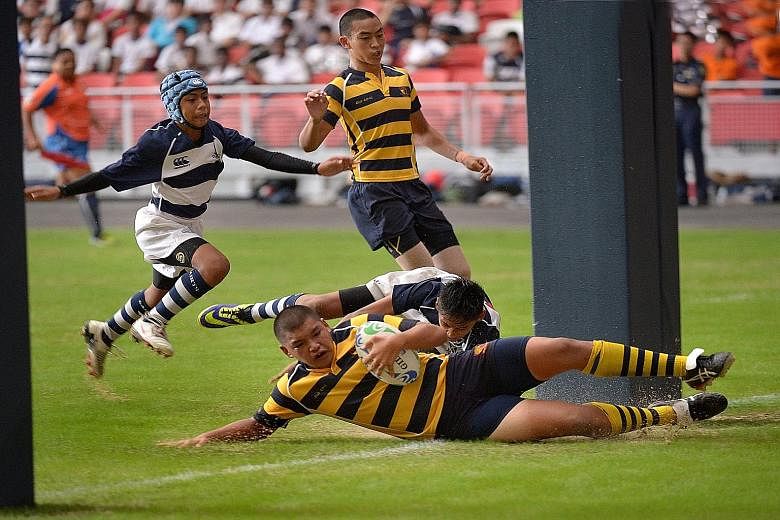To enter a grand stadium for the first time as a spectator is to complete a pilgrimage; to play in it, through some act of God or deep wallets, is miraculous. The face of grown men just returned from a golf round at Augusta is often suffused with wonder. These adults have walked the same ground as Jack Nicklaus and now recount stories of their near-religious experience with a voice that is almost boyish.
So imagine a girl, or a boy, let loose on the same geography as their heroes? Imagine the dizziness at treading a ground they have only gazed at from their seats? Imagine a 13-year-old's heart as she rises from the blocks in the same lane in which Shanti Pereira won SEA Games gold? Or a 12-year-old's thrill as her name appears on the OCBC Aquatic Centre scoreboard?
To put it in a word most generations know: Cool.
So let's send a memo to the excellent Singapore Sports Hub, which was officially opened on Sunday by Prime Minister Lee Hsien Loong:
Please re-invite Neymar. Check if the All Blacks want to drop by. Ask Michael Phelps if he wants a dip.
And let more school kids onto the grounds.
Let's let them play a few finals on the premises every year. One year football, next rugby. Track now and then. Swimming every odd year. Till every sport gets a chance, till it becomes routine.
Let's let them gaze into the stands, see life from the other end, be so dazzled that some may want to turn the stadium into their place of work. Or as Derek Jeter once said: "My office is at Yankee Stadium. Yes, dreams do come true." Let's turn the phrase, "walking in their footsteps" from cliche to something real.
Last year, in the first and only schools final to be played in the National Stadium, Anglo-Chinese School (Independent) beat St Andrew's Secondary in the National C Division rugby final. ACS (I) coach Adrian Chong says his boys were "thrilled" to play there and he was envious. "I wish," he smiles down the phone line, "I had the chance to play there."
As experiments go, this was a grand idea. "There are," said Chong, "not a lot of opportunities for them to play in front of a big crowd and in a stadium environment. And this is an iconic stadium, it's our stadium. It means a lot to any aspiring sportsperson."
Part of hero worship is imitation. The kid chooses his champion's hairstyle. Wears his shirt number. Buys his racket. Preferably doesn't get Stan Wawrinka's tattoo inscribed because it's 12 words, which is more like a speech. But the next, grand step in this impersonation would be to get onto the same field.
For if they do, they don't forget. Like Martin Wong and the tunnel.
Eight years ago, Wong, a footballer then for Raffles Junior College, played in the last schools game on the old National Stadium. He remembers the larger crowd, the real grass, the locker rooms. But it's waiting in the tunnel - an image we see on TV and associate with grown-up football - and walking out to a roll-call of names which is imprinted most deeply on him. "It felt great," he said. It is the football experience at its most authentic.
All of us spend a lifetime on the outside. Even Pete Sampras, 17, on his first trip to Wimbledon, went directly to Centre Court and sat there for 10 quiet minutes. When some of us do get in, the strength of the experience can shake us.
In the 1980s, a friend remembers playing at Calcutta's Eden Gardens, a cricketing temple where once 100,000 people got in with a shoehorn. Even though he understood what was about to happen, he was still overcome with awe, trying to play perhaps better than he could. This, in its own way, is inspiration.
This is what we want for kids. To be influenced. As Muhammad Rozaidi Subadi was when he scored the only goal in the National Stadium on Sunday when Seng Kang Secondary school beat Hong Kah Secondary in a C-division quarter-final. "One day," he told reporters, "I want to score goals at the national stadium regularly as a national footballer."
Much like Rozaidi, an enthusiasm for sport - built from ideas, money and hard work - has penetrated Singapore. At the SEA Games the crowds responded, but enthusiasm, like all fires, eventually dies. It has to be stoked constantly and giving kids the occasional dream outing might play a small role.
Maybe a few who play in a mighty stadium may turn professional one day; maybe the rest, tied to that stadium forever, will stay as fans. All of them loving sport, which surely is what we're trying to evoke. Great stadiums, we believe, are great stages which exist for great talents. Ronaldo's feet sing at the Bernabeu as opera singers do at La Scala and if this is great art, well then it is also supposed to be great business.
But perhaps stadiums, to which the word "national" are affixed, belong to everyone in that nation. To let young citizens play within them is to give them a wondrous sense of ownership. Of course, on most days these will remain serious arenas. But on some days, to the sound of giddy delight within, they deserve to become playgrounds.


